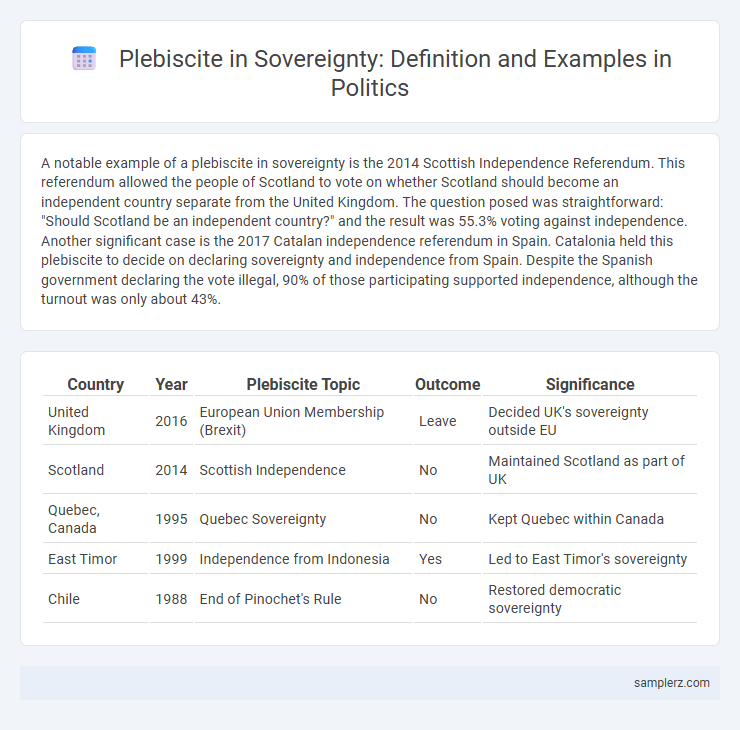A notable example of a plebiscite in sovereignty is the 2014 Scottish Independence Referendum. This referendum allowed the people of Scotland to vote on whether Scotland should become an independent country separate from the United Kingdom. The question posed was straightforward: "Should Scotland be an independent country?" and the result was 55.3% voting against independence. Another significant case is the 2017 Catalan independence referendum in Spain. Catalonia held this plebiscite to decide on declaring sovereignty and independence from Spain. Despite the Spanish government declaring the vote illegal, 90% of those participating supported independence, although the turnout was only about 43%.
Table of Comparison
| Country | Year | Plebiscite Topic | Outcome | Significance |
|---|---|---|---|---|
| United Kingdom | 2016 | European Union Membership (Brexit) | Leave | Decided UK's sovereignty outside EU |
| Scotland | 2014 | Scottish Independence | No | Maintained Scotland as part of UK |
| Quebec, Canada | 1995 | Quebec Sovereignty | No | Kept Quebec within Canada |
| East Timor | 1999 | Independence from Indonesia | Yes | Led to East Timor's sovereignty |
| Chile | 1988 | End of Pinochet's Rule | No | Restored democratic sovereignty |
Defining Sovereignty: The Role of Plebiscites
Plebiscites serve as a direct democratic tool allowing the population to express their will on matters of sovereignty, such as independence or territorial changes. Notable examples include the 2014 Scottish Independence Referendum, where citizens voted on Scotland's potential secession from the United Kingdom. These votes exemplify how plebiscites contribute to defining sovereignty by legitimizing political decisions through popular consent.
Historical Overview of Sovereignty Plebiscites
The 1962 Algerian independence plebiscite stands as a landmark example of sovereignty exercises, where over 90% of voters endorsed independence from France, fundamentally reshaping North African geopolitics. Likewise, the 1999 East Timor referendum demonstrated a pivotal sovereignty plebiscite, with an overwhelming majority favoring independence from Indonesia, leading to UN administration and eventual nationhood. These historical votes exemplify citizens' power to directly influence sovereignty status, often catalyzing significant political and territorial transformations.
Case Study: The 2014 Crimean Status Referendum
The 2014 Crimean Status Referendum exemplifies a plebiscite conducted to determine regional sovereignty, where over 95% of voters purportedly supported joining the Russian Federation. This referendum, held under controversial circumstances and lacking broad international recognition, highlighted the complexities of self-determination in contested territories. The event significantly altered geopolitical dynamics, with Russia annexing Crimea despite widespread global condemnation and sanctions.
Quebec Referendums: Pursuit of Canadian Sovereignty
The Quebec Referendums of 1980 and 1995 serve as pivotal examples of plebiscites addressing sovereignty within Canada, where Quebec voters decisively engaged with questions of political independence. In the 1995 referendum, the vote narrowly favored remaining part of Canada, with 50.58% opposed to sovereignty and 49.42% in support, highlighting deep divisions within the province. These referendums underscore the complex interplay between regional identity and national unity, reflecting ongoing debates about Quebec's political future and Canadian sovereignty.
South Sudan’s 2011 Independence Plebiscite
The 2011 South Sudan Independence Plebiscite served as a landmark example of self-determination through a legally sanctioned electoral process, where over 98% of voters chose independence from Sudan. This plebiscite followed the Comprehensive Peace Agreement signed in 2005, ending decades of civil war and granting Southern Sudan the right to decide its sovereignty. The outcome led to the formation of the Republic of South Sudan, becoming the world's newest nation and a case study in peaceful resolution of secessionist conflicts.
The Scottish Independence Referendum of 2014
The Scottish Independence Referendum of 2014 was a landmark plebiscite on sovereignty, where 55.3% of voters chose to remain part of the United Kingdom while 44.7% supported full independence. This democratic process was authorized by the Edinburgh Agreement between the Scottish Government and the UK Government, emphasizing its legal legitimacy under UK and international law. The referendum significantly influenced debates on self-determination and regional governance within the UK and across global political contexts.
The Saar Statute Referendum (1955)
The Saar Statute Referendum in 1955 was a pivotal plebiscite held to determine the sovereignty status of the Saar region, a contested territory between France and West Germany after World War II. Over 67% of voters rejected the proposed European Saar statute, favoring reintegration with West Germany instead of becoming an autonomous territory under European administration. This referendum decisively shaped the Saar's political future, reinforcing national sovereignty and influencing post-war European border settlements.
The Norwegian-Swedish Dissolution Plebiscite (1905)
The Norwegian-Swedish Dissolution Plebiscite of 1905 was a pivotal moment in constitutional history, where an overwhelming 99.95% of Norwegian voters supported the dissolution of the union with Sweden, asserting national sovereignty. This plebiscite exemplifies the use of direct democracy in peacefully resolving territorial and sovereignty disputes through popular mandate. It set a precedent for modern plebiscitary practices by legitimizing Norway's independence under international law without resorting to armed conflict.
Eritrea’s Independence Referendum (1993)
The Eritrea Independence Referendum held in 1993 stands as a pivotal plebiscite in modern sovereignty movements, where over 99% of Eritrean voters opted for full independence from Ethiopia. This referendum was supervised by the United Nations, ensuring international legitimacy and fostering peaceful transition of power. The outcome established Eritrea as a sovereign nation, highlighting plebiscites' critical role in self-determination and the reshaping of national borders.
Lessons Learned from Sovereignty Plebiscites
The 2014 Crimean sovereignty plebiscite highlighted the importance of international recognition and transparent voting processes in determining legitimate self-determination outcomes. Lessons learned emphasize the necessity of clear legal frameworks and unbiased monitoring to prevent disputes and ensure the plebiscite reflects the genuine will of the population. Effective communication and preparedness for post-vote geopolitical consequences are crucial for maintaining regional stability after sovereignty plebiscites.

example of plebiscite in sovereignty Infographic
 samplerz.com
samplerz.com